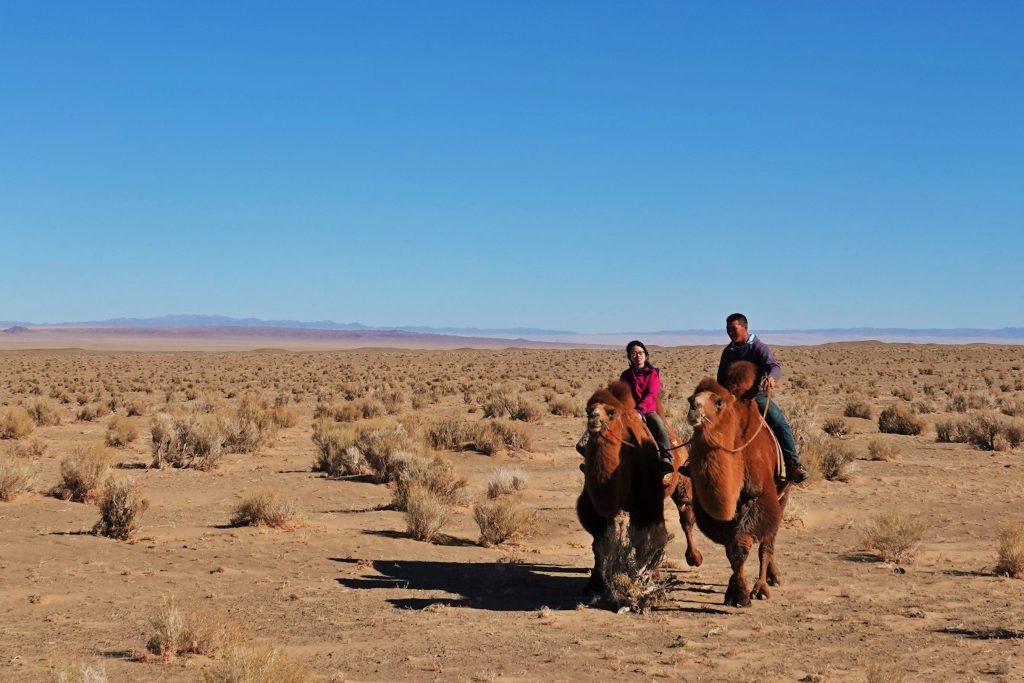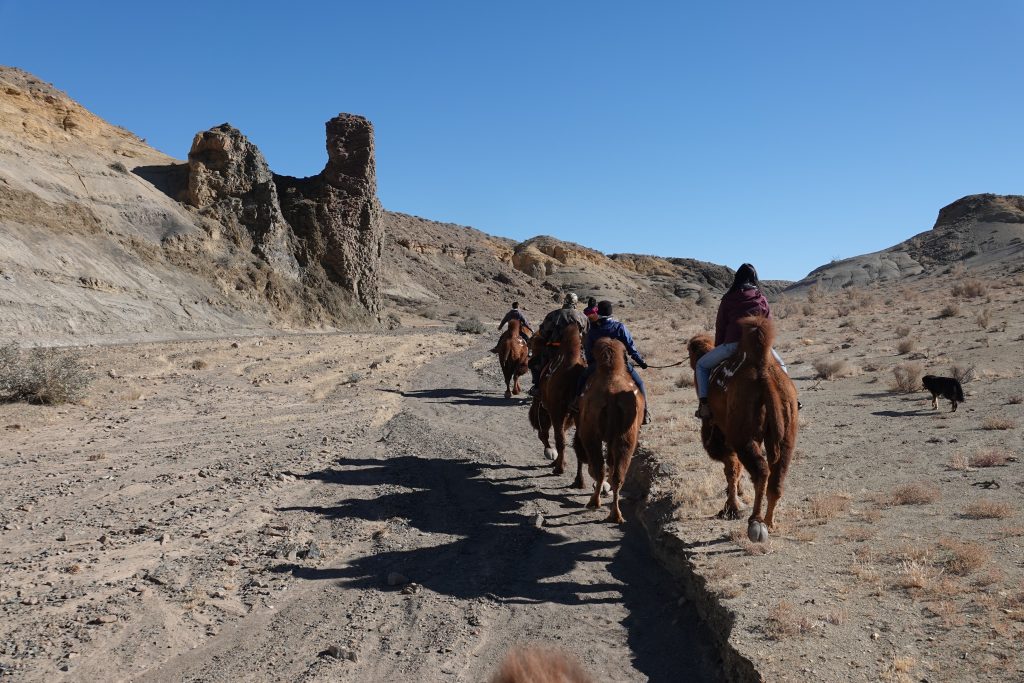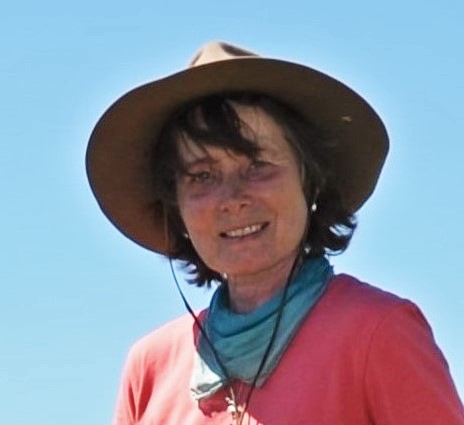No products in the cart.
Slow Travel in Mongolia
Slow Travel in Mongolia with Stone Horse Expeditions
 The concept of “Slow Travel” stands for taking in surroundings at a relaxed pace, versus a sightseeing race, for experiencing the natural environment close-up, for immersing yourself in and learning about local culture. It has been described (https://www.smartertravel.com/art-slow-travel/an) as “off- shoot of the “Slow Food” movement that originated in Italy as a response to fast food chains opening in Rome”.
The concept of “Slow Travel” stands for taking in surroundings at a relaxed pace, versus a sightseeing race, for experiencing the natural environment close-up, for immersing yourself in and learning about local culture. It has been described (https://www.smartertravel.com/art-slow-travel/an) as “off- shoot of the “Slow Food” movement that originated in Italy as a response to fast food chains opening in Rome”.
All our tours and activities easily qualify as Slow Travel in Mongolia. Horseback travel, with pack horses carrying all we need for comfortable wilderness camping and cooking, is still at the heart of our operations. They are defined by experiencing cultural and wilderness landscapes, bonding with your trail horse, and enjoying scenic camp sites, good food and drink made from scratch in our camp kitchen, and last not least – the company of your fellow travelers.
Scheduled in between horse treks, our Gobi Desert Tours also emphasize experiences of natural landscapes and scenery, they include hiking and camel riding, and they are enriched by visiting with local herder families, joining in local festivities or staying overnight in a traditional ger.
Popular and shorter in duration than horse treks and Gobi Desert tours usually is the Ger Stay – or Home Stay with a herder family. It offers opportunity to see the real daily life of Mongolian herders, to take part in chores of livestock herding, milking, preparing meals – or just hang out and enjoy rural tranquility, go for a short horse ride or a walk in the hills.
Slow Travel in Mongolia on Camel Back
But one of our tours is fitting the definition of Slow Travel in a very special way. The most unique travel activity based on local traditions, yet with a truly exotic appeal, may be “Camel Trekking in the Gobi Desert.” Not only does it entail the aspects of “experiential travel”, taking in the local cultural and natural environment, but it can also be truly slow in the simple meaning of slow paced. And that is a nice feature of this adventure.
Camel riding is part of Stone Horse Expeditions’ Gobi desert adventures, whether it’s an hours’ ride to get a taste of this slow travel mode, or whether it’s a six day trek with camping at scenic desert landscape sites.
Camels and the Nomadic Lifestyle in the Gobi
Camels are an important animal for the nomadic herders that utilize the vast landscapes of Mongolia’s South to maintain their livelihood. Camels give milk, from which a variety of local dairy products are made, and wool based on which a domestic industry has been developed for garments and blankets. Camel wool also is a raw material for herder household items, such as ropes for various uses.
The most important use of the camel for the herders’ lifestyle and livelihood however, is for transport and travel. And it is only less than hundred years ago that camels played an important role in cross border trade, when caravans of camel brought goods to neighboring countries.
Transport use includes both the carrying of the dwelling and all the possessions of a nomadic herder family when they move to new pastures, as well as riding the camel for herding or other reasons. The camel as means of transportation is of crucial importance, for the survival of the herders as well as for the long term well being of the dry lands of the Gobi. Mobility of the pastoralists is the key to using these arid lands sustainably. For millennia, herders have grazed their herds, following the rains and the growth of vegetation.
Winter Camel Trekking for a Great Experience of Slow Travel in Mongolia
The Stone Horse Expedition “Gobi Desert Tour”, as well as the “Gobi Crossing” offer opportunity to ride camels. For beginners, and in case of camel riding pretty much everybody is, the camel guides or one of our staff with camel riding experience will lead the guest’s camel. With a group of novice camel riders, each rider will lead another rider to their right hand, and a little caravan is formed to make its way across the desert landscape.
The chosen camels are calm and well behaved, and if you are confident or curious enough, it will be no problem, after you have gotten a bit of a feeling for reining the camel, to ride on your own. If you are a horse rider, some aspects will be familiar. It is communicating with an animal, both with your body language, posture and movements, through voice signals, and through the rein.
Like horses in Mongolia, camels are exposed to predators in the landscape they inhabit, and they will be suspicious of a shape that might represent a predator, and for a short split second might make a quick move – until they realize it’s the herder’s dog that just came around the shrubs…
On the other hand, expect different handling, reactions and experiences with camels than with horses. They are a different animal with traits unique to their species. The rein of camels in Mongolia is only on one side, the left, and attached to the little wood that’s penetrating the camel’s nose. Steering to the left is obvious, and steering to the right is by flicking the rein over a bit to the right and giving a pull. Holding him back is of course by tightening the rein, and you give him the rein to let him run just like you do with a horse.
Mounting a camel is of course very different from getting on horseback. The camel guide will give the camel the voice signal to lie down. To help it a bit, he or she may pull the camel a bit to make him circle, to encourage the animal to begin folding its long legs. You want to select a nice sandy, or at least smooth and even spot for this procedure. Once the camel is settled down, its time to mount and find your seat between the humps.
From now on you will look onto the world ahead of you past the wool covered hump. Many of your photos of fellow camel riders and of the desert landscape will have this fluffy brown hump in the foreground. From late autumn on wards, camels will have a nice coat of warm wool. It makes for a cozy seat between the humps, and one can smell the wool.
Dismounting a camel can be done in two ways. You can hug the hump in front of you, get your right leg over and then slide down, let go and jump to the ground. Or, you have mastered the commands and your camel lies down for you, or the camel guide will make your mount drop down so you can dismount easily.
Slow Travel in Mongolia – Ride and Hike
While camels can move fast, and trotting is great to make some distance – just like on horseback – travel on camel back is usually slower paced when compared to horse trekking. It is actually a nice aspect of camel trekking that one can get off and walk for a while, either leading the camel or entrusting the reins to the camel guide. It makes for nice, slow travel whereby you really experience the landscape and get a feel of the desert.
Slow Travel in Mongolia – Learn about Local Culture, Experience Local Hospitality
Relying on camel guides, the slow traveler in the Gobi inevitably will be in close contact with local community members and experience local culture firsthand. Staying overnight in a ger, the traditional felt tent the ingenious construction of which has served the needs of nomads for mobility for thousands of years all over central Asia and Mongolia, is just one part of the cultural learning. Enjoying local foods, namely dairy, meat dishes and home-made fried breads is another great travel experience.
And depending on the season, slow travel in Mongolia will also provide opportunities to witness activities of nomadic herder families such as combing cashmere from goats, cutting the wools of camels, preparing winter camp sites. And with good planning, or lucky coincidence, a camel trek or other Gobi tour will chance upon local festivities. A Camel Festival in early March has already become a tradition in Mongolia’s South Gobi, and a Yak Festival in May is gaining popularity.
Apart from these festivals, there are local Naadam celebrations at different times of the year, with horse racing, archery and wrestling. And the event most steeped in old traditions perhaps is Tsagaan Sar, the Lunar New Year Festival which mostly falls into the month of February. The last of our Winter Camel Treks is scheduled so as to take in the Lunar New Year celebrations in 2019.
Contact us to find out more about Slow Travel in Mongolia with Stone Horse Expeditions, and to discuss Your Gobi Adventure!
Thank you, we look forward to hearing from you!
Sabine



